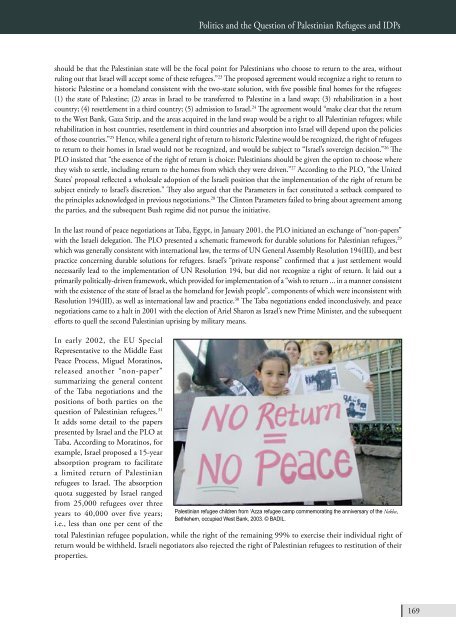BADIL Resource Center for Palestinian Residency and Refugee
BADIL Resource Center for Palestinian Residency and Refugee
BADIL Resource Center for Palestinian Residency and Refugee
You also want an ePaper? Increase the reach of your titles
YUMPU automatically turns print PDFs into web optimized ePapers that Google loves.
Politics <strong>and</strong> the Question of <strong>Palestinian</strong> <strong>Refugee</strong>s <strong>and</strong> IDPs<br />
should be that the <strong>Palestinian</strong> state will be the focal point <strong>for</strong> <strong>Palestinian</strong>s who choose to return to the area, without<br />
ruling out that Israel will accept some of these refugees.” 23 The proposed agreement would recognize a right to return to<br />
historic Palestine or a homel<strong>and</strong> consistent with the two-state solution, with five possible final homes <strong>for</strong> the refugees:<br />
(1) the state of Palestine; (2) areas in Israel to be transferred to Palestine in a l<strong>and</strong> swap; (3) rehabilitation in a host<br />
country; (4) resettlement in a third country; (5) admission to Israel. 24 The agreement would “make clear that the return<br />
to the West Bank, Gaza Strip, <strong>and</strong> the areas acquired in the l<strong>and</strong> swap would be a right to all <strong>Palestinian</strong> refugees; while<br />
rehabilitation in host countries, resettlement in third countries <strong>and</strong> absorption into Israel will depend upon the policies<br />
of those countries.” 25 Hence, while a general right of return to historic Palestine would be recognized, the right of refugees<br />
to return to their homes in Israel would not be recognized, <strong>and</strong> would be subject to “Israel’s sovereign decision.” 26 The<br />
PLO insisted that “the essence of the right of return is choice: <strong>Palestinian</strong>s should be given the option to choose where<br />
they wish to settle, including return to the homes from which they were driven.” 27 According to the PLO, “the United<br />
States’ proposal reflected a wholesale adoption of the Israeli position that the implementation of the right of return be<br />
subject entirely to Israel’s discretion.” They also argued that the Parameters in fact constituted a setback compared to<br />
the principles acknowledged in previous negotiations. 28 The Clinton Parameters failed to bring about agreement among<br />
the parties, <strong>and</strong> the subsequent Bush regime did not pursue the initiative.<br />
In the last round of peace negotiations at Taba, Egypt, in January 2001, the PLO initiated an exchange of “non-papers”<br />
with the Israeli delegation. The PLO presented a schematic framework <strong>for</strong> durable solutions <strong>for</strong> <strong>Palestinian</strong> refugees, 29<br />
which was generally consistent with international law, the terms of UN General Assembly Resolution 194(III), <strong>and</strong> best<br />
practice concerning durable solutions <strong>for</strong> refugees. Israel’s “private response” confirmed that a just settlement would<br />
necessarily lead to the implementation of UN Resolution 194, but did not recognize a right of return. It laid out a<br />
primarily politically-driven framework, which provided <strong>for</strong> implementation of a “wish to return ... in a manner consistent<br />
with the existence of the state of Israel as the homel<strong>and</strong> <strong>for</strong> Jewish people”, components of which were inconsistent with<br />
Resolution 194(III), as well as international law <strong>and</strong> practice. 30 The Taba negotiations ended inconclusively, <strong>and</strong> peace<br />
negotiations came to a halt in 2001 with the election of Ariel Sharon as Israel’s new Prime Minister, <strong>and</strong> the subsequent<br />
ef<strong>for</strong>ts to quell the second <strong>Palestinian</strong> uprising by military means.<br />
In early 2002, the EU Special<br />
Representative to the Middle East<br />
Peace Process, Miguel Moratinos,<br />
released another “non-paper”<br />
summarizing the general content<br />
of the Taba negotiations <strong>and</strong> the<br />
positions of both parties on the<br />
question of <strong>Palestinian</strong> refugees. 31<br />
It adds some detail to the papers<br />
presented by Israel <strong>and</strong> the PLO at<br />
Taba. According to Moratinos, <strong>for</strong><br />
example, Israel proposed a 15-year<br />
absorption program to facilitate<br />
a limited return of <strong>Palestinian</strong><br />
refugees to Israel. The absorption<br />
quota suggested by Israel ranged<br />
from 25,000 refugees over three<br />
years to 40,000 over five years;<br />
i.e., less than one per cent of the<br />
<strong>Palestinian</strong> refugee children from ‘Azza refugee camp commemorating the anniversary of the Nakba,<br />
Bethlehem, occupied West Bank, 2003. © <strong>BADIL</strong>.<br />
total <strong>Palestinian</strong> refugee population, while the right of the remaining 99% to exercise their individual right of<br />
return would be withheld. Israeli negotiators also rejected the right of <strong>Palestinian</strong> refugees to restitution of their<br />
properties.<br />
169

















